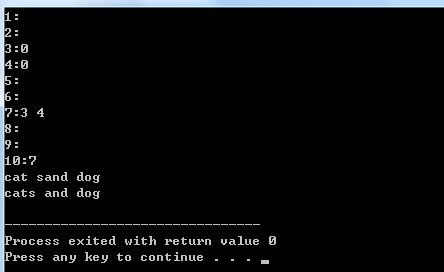LeetCode140:Word Break II
题目:
Given a string s and a dictionary of words dict, add spaces in s to construct a sentence where each word is a valid dictionary word.
Return all such possible sentences.
For example, given
s = "catsanddog",
dict = ["cat", "cats", "and", "sand", "dog"].
A solution is ["cats and dog", "cat sand dog"].
解题思路:
这道题是上一道题Word Break升级版,难度更大些,需要用DP+DFS解决
这里采用DP中的自底向上实现,dp[i]表示前i个字符能否进行Wordbreak。当求解dp[i]时,可利用已经求解的dp[i-1],
dp[i-2]…dp[1],dp[0]进行求解。
对于dp[n]的求解,我们可以将n个字符进行切分求解,分为前i个字符和后n-i个字符,i可以为(0,1,2,3,4…n-1)
假设i为1时,可根据dp[i]和后面的n-1个字符组成的单词是否在dict中来判断dp[n],只要i(0,1,2,3,4…n-1)其中一种
情况为真,则dp[n]为true,表示可以进行workbreak。
因为本题需要重构结果,所以必须要有一个数据结构来保存每段长度的切割方案,这里我用unordered_map<int, vector<int> >进行保存,key为字符长度,vector保存该key对应的切割方案。
如何求得unordered_map<int, vector<int> >中的值呢?那就应该利用求解dp[i]时,每当有一种切割方案使得dp[i]为true时,将其对应的切割位置存放到i对应的vector中,待之后用于结果重构。
unordered_map<int, vector<int> >求得后,接下来是采用DFS算法进行结果重构,如代码执行结果图,当长度为10时,有一种切割方案,即在长度为7的位置进行切割,然后长度为7的切割方案又有两种3和4,长度为3和4时,切割方案都为0,所以采用DFS时,遍历顺序为7,3,0然后获得一种结果,之后回溯到7,4,因为4的切割方案为0,所以为7,4,0,又是一种结果。
实现代码:
#include <iostream> #include <string> #include <vector> #include <unordered_set> #include <unordered_map> using namespace std; /* Given a string s and a dictionary of words dict, add spaces in s to construct a sentence where each word is a valid dictionary word. Return all such possible sentences. For example, given s = "catsanddog", dict = ["cat", "cats", "and", "sand", "dog"]. A solution is ["cats and dog", "cat sand dog"]. */ class Solution { public: vector<string> wordBreak(string s, unordered_set<string> &dict) { vector<string> retvec; if(s.size() == 0 || dict.size() == 0) return retvec; int len = s.size(); vector<bool> dp(len+1, false);//保存状态,dp[i]表示前i个字符是否可以进行wordBread unordered_map<int, vector<int> > hash_map;// 存放使得dp[i]为true的切割方案 dp[0] = true; for(int i = 1; i <= len; i++) { vector<int> vec; for(int j = 0; j < i; j++) { if(dp[j] && dict.count(s.substr(j, i-j)) == 1)//对前i个字符进行切分时,只要有一种情况为true,则dp[i]=true { dp[i] = true; vec.push_back(j);//放使得dp[i]为true的切割方案 } } hash_map[i] = vec; } for(int k = 1; k <= len; k++) { vector<int> tvec = hash_map[k]; cout<<k<<":"; vector<int>::iterator iter; for(iter = tvec.begin(); iter != tvec.end(); ++iter) { cout<<*iter<<" "; } cout<<endl; } vector<int> curVec; getResult(hash_map, s, len, retvec, curVec); return retvec; } //采用DFS解决 void getResult(unordered_map<int, vector<int> > &hash_map,string s, int len, vector<string> &retvec, vector<int> &curVec) { if(len == 0) { string t; int start = 0; for(int i = curVec.size()-2; i >= 0; i--) { int c = curVec[i]; t += s.substr(start, c-start); t += " "; start = c; } t += s.substr(curVec[0]); retvec.push_back(t); return ; } vector<int> tvec = hash_map[len]; vector<int>::iterator iter; for(iter = tvec.begin(); iter != tvec.end(); ++iter) { curVec.push_back(*iter); getResult(hash_map, s, *iter, retvec, curVec); curVec.pop_back(); } } }; int main(void) { string s("catsanddog"); unordered_set<string> dict; dict.insert("cat"); dict.insert("cats"); dict.insert("and"); dict.insert("sand"); dict.insert("dog"); Solution solution; vector<string> retvec = solution.wordBreak(s, dict); vector<string>::iterator iter; for(iter = retvec.begin(); iter != retvec.end(); ++iter) cout<<*iter<<endl; return 0; }
执行结果:





